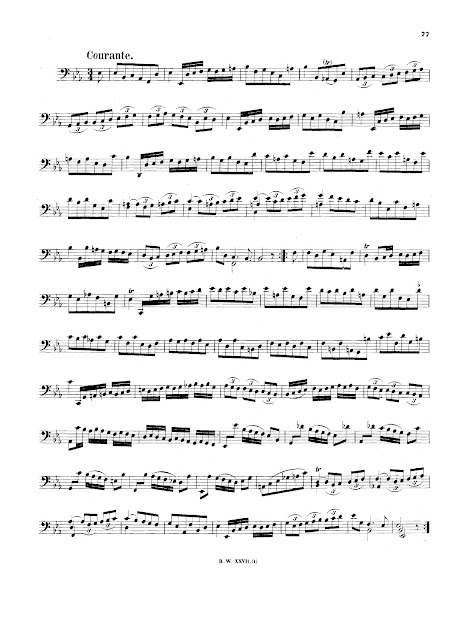CCCII. BACH, J.S. (1685-1750)
The open strings of a cello:
The Circle of Fifths:
Notice that when we start from C Major and go the right -- into the sharp keys -- there are many notes in common with the cellos' open strings, within the triads of the key:
- C Major: C and G;
- G Major: G and D;
- D Major: D and A;
- A Major: A
When go to the left -- into the flat keys, the number of open strings quickly decreases:
- F Major: A and C;
- B-Flat Major: D
- E-Flat Major: G
Thus, the cellist in this key is almost never playing an open string. This gives the music a deeper, more burnished timbre, than say, G or D Major ...
Preludium
Preludium
Compare this to the Prelude of the First Suite in G Major -- a constant flow of notes with the same rhythmic value. And here, Bach uses the first note of each bar as a pedal point for changing harmony ...
The first two bars contain all the notes of a pure E-Flat Major triad.
In this third and fourth bar, he introduces a D-Flat, making it into a E-Flat dominant seventh.
The first two bars contain all the notes of a pure E-Flat Major triad.
In this third and fourth bar, he introduces a D-Flat, making it into a E-Flat dominant seventh.
In bars five and six he resolves the dominant chord to A-Flat Major, in its second inversion -- the E-Flat in the root.
This pattern continues, as Bach gradually moves into far-reaching harmonic territory. The whole thing comes to a halt on a held low C-Sharp (black arrow) and moves into a cadenza-like section (blue arrow) which alternates between the pedal point stuff. It all ends on a lovely no-open-strings quadruple stop!
This pattern continues, as Bach gradually moves into far-reaching harmonic territory. The whole thing comes to a halt on a held low C-Sharp (black arrow) and moves into a cadenza-like section (blue arrow) which alternates between the pedal point stuff. It all ends on a lovely no-open-strings quadruple stop!
Allemande
Things calm down for this lovely dance, again with imaginative harmonic movement.
Courante
How lovely is Ma's delicate touch in this triple-meter dance? He skips over the notes like an ice skater on a glistening pond.
Sarabande
The Sarabande is always the high point in these suites, as far as emotional content ... there are plenty of double- and triple-stops and ends in a satisfying E-Flat major arpeggio ...
Bourée I
Bourée II
Although different in character, the second Bourée returns to the first ...
Gigue
From the Irish jig, of course -- evolving into the loveliest and briskest movement of the suites. Ma plays it with exquisite sensitivity.













No comments:
Post a Comment